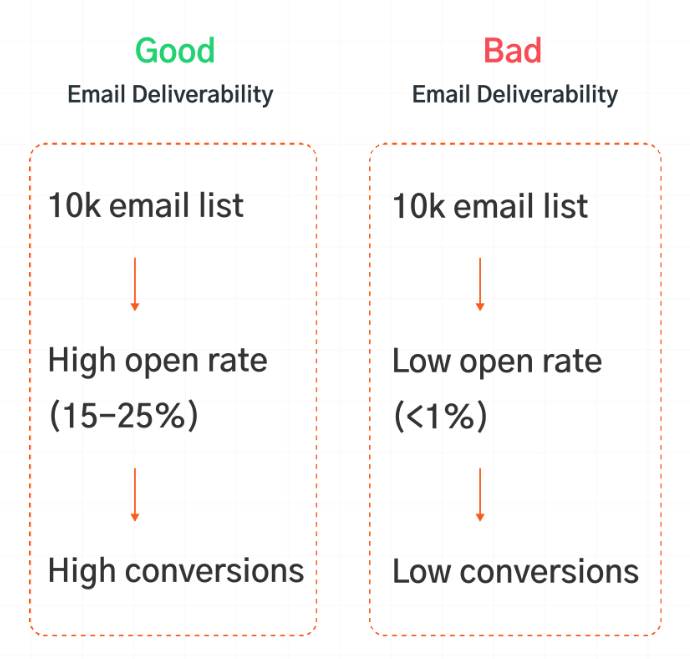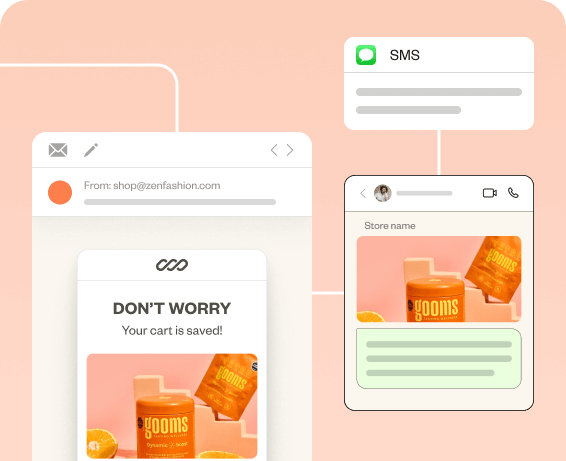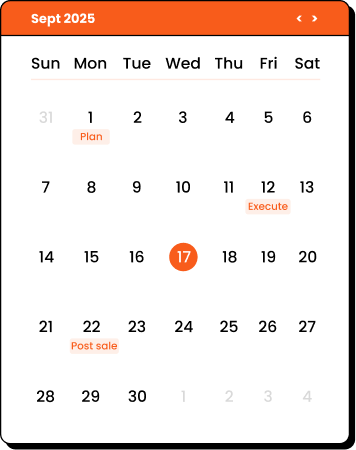Email marketing metrics – you know they’re important, but they can feel like a maze. Open rates, click-throughs, bounces – why track them all?
Here’s the deal: without these metrics, you’re flying blind. You’re sending emails, hoping for the best without knowing what’s working.
But when you’ve got your email KPI metrics locked down? You start seeing exactly where people engage, where they lose interest, and how you can keep them clicking, buying, and coming back for more.
In this blog, we explain,
- What are email marketing metrics?
- What are the most important email marketing metrics?
- How to measure email marketing metrics?
Track which email campaign converts more and abandoned cart revenue with Retainful’s advanced analytics.
What are email marketing metrics?
Email marketing metrics are the key performance indicators (KPIs) that help you understand how well your email campaigns are performing.
Tracking these email marketing success metrics lets you see what’s working, where you’re losing engagement, and how to optimize your email marketing strategy for better results.
12 Most Important Email Marketing Metrics to Track and Benchmark
The most important email marketing metrics & KPIs to track are:
- Open rate
- Click-through rate
- Conversion rate
- Bounce rate
- Unsubscribe rate
- Email deliverability
- List growth rate
- Engagement rate
- Email sharing/ forwarding rate
- Spam compliant rate
- Overall ROI
- Time spent reading
Let’s look at these email marketing performance metrics in detail.
1. Email Open Rate
The email open rate is the percentage of recipients who opened your email.
This metric of email marketing is a measure of how effective your subject line and timing are.
Open rate formula: (Emails Opened / Emails Delivered) x 100
A good email open rate is 20-30%, and a bad open rate is below 10.
2. Click-Through Rate (CTR)
CTR measures the percentage of people who click a link in your email. CTR is the most important metric in email marketing.
This email marketing engagement metric tells you if your marketing email content and call-to-action (CTA) are compelling enough to drive engagement.
CTR Formula: (Unique Clicks / Emails Delivered) x 100
A good click rate in email marketing is 5% or higher, and a bad CTR is anything below 1%.
Why should you focus on email CTR more than the open rate?
A click means they cared enough to take the next step, to see what you’re really offering. It’s a commitment. CTR email marketing campaign metric is what drives traffic, leads, and, ultimately, sales.
3. Conversion Rate
Conversion rate email KPI tracks the percentage of recipients who completed the desired action, like making a purchase or signing up.
This is one of the most important email marketing metrics, as it directly ties your email campaign to your revenue goals.
Conversion rate Formula: (Conversions / Emails Delivered) x 100
Every email marketing campaign has a different conversion rate. The top 5 email marketing campaigns that have high conversion rates are:
- The high conversion rate award goes to welcome email campaigns – 8-12%.
- Abandoned cart emails – 5-10%
- Product recommendation emails – 4-6%
- Win-back emails – 3-5%
- Transactional emails – 2-4%
4. Bounce Rate
Bounce rate is a metric to measure email marketing success that tells you the percentage of emails that couldn’t be delivered to recipients. There are two types of bounces:
- Soft Bounce: Temporary issues, like a full inbox.
- Hard Bounce: Permanent issues, like an invalid email address.
Bounce rate formula: (Bounced Emails / Emails Sent) x 100
Here are the common reasons for email bounces:
- Invalid email addresses
- Full mailboxes
- Email size too large
- The recipient has blocked you
When it comes to this bounce rate email marketing metric benchmark, if your bounce rate is consistently above 5%, it’s essential to take action.
5. Unsubscribe Rate
This key email marketing metric shows the percentage of recipients who unsubscribed after receiving your email.
A high unsubscribe rate in the email marketing analytics metric could signal that your content isn’t relevant or engaging or that you’re sending it too frequently.
Unsubscribe rate formula: (Unsubscribes / Emails Delivered) x 100
Common reasons for high unsubscription rate are:
- You are overdoing it – sending too many emails
- Too salesy
- Lack of email personalization
- Bad mobile experience
- Irrelevant content
6. Email deliverability
One email marketing metric that makes or breaks the success of your email marketing campaigns is email deliverability.
No matter how good your email template design and your messaging is, if your emails don’t land in the inbox, they WILL never see the light of day.
Achieving good email deliverability mainly hinges on the content quality and the sender’s reputation.
This email marketing metrics benchmark is above 98%. Anything below 80% needs attention.
Email Deliverability Rate formula = (Email delivered / Emails Sent − Emails Bounced) × 100

7. List Growth Rate
The list growth rate shows how quickly you are growing your email list.
This email marketing analytics metric takes into account new subscribers and removes unsubscribes, giving you a net growth rate.
List growth rate formula: [(New Subscribers – Unsubscribes) / Total Subscribers] x 100
Here is what a good email list growth rate looks like:
If you are a new business just starting with email marketing, a good email list growth rate can be anywhere from 2-5% per month.
If you start with a small email list of 100 subscribers and grow it by 5%, that’s 5 new subscribers per month.
8. Engagement Rate
The engagement rate email KPI combines various email marketing metrics, such as opens and clicks, to provide an overall measure of how engaged your audience is with your automated emails.
Some email marketing platforms calculate this email marketing engagement metric as a combination of open rates, CTR, and conversions.
9. Email Sharing/Forwarding Rate
This email marketing engagement metric tracks how often your emails are shared or forwarded, indicating that your content resonates enough for recipients to share it with others.
Email forwarding rate formula: (Shares or Forwards / Emails Delivered) x 100
If you include a specific link or button in the email for forwarding, track the clicks on this link and measure this email marketing engagement metric.
10. Spam Complaint Rate
The spam complaint rate is an email marketing analytics metric that tells you the percentage of recipients who marked your email as spam. A high rate could hurt your email deliverability and sender reputation.
Spam compliant rate formula: (Spam Complaints / Emails Delivered) x 100
11. Overall ROI (Return on Investment)
Email ROI is the ultimate email marketing success metric.
ROI measures the profitability of your email campaigns. This email KPI shows how much revenue you’re generating compared to the cost of your email marketing efforts.
Email ROI Formula: [(Total Revenue – Total Cost) / Total Cost] x 100
Email marketing is known to have a high ROI compared to other marketing channels, giving you $44 for every dollar spent.
12. Time Spent Reading
Time spent reading is an email marketing success metric that measures how long recipients spend on your email.
This email marketing performance metric can help you understand whether your email content is engaging and easy to read.
How to increase this email marketing engagement metric?
- Personalizing emails through email segmentation
- Not sending too many emails
- Nailing the email timing
- Including product recommendations based on products viewed and purchase history.
How to measure email marketing performance metrics?
You can track these metrics for email marketing with the help of tools like the ones below:
1. Email Analytics Tools
You can track most of the email marketing metrics with an email automation software like Retainful, MailChimp, Klaviyo, and more.
These email marketing software give you an accurate measure of open rates, click-through rates (CTR), and bounce rates.
Related Reading: Explore our top email marketing software comparison guides and choose the best one:
10 Best Klaviyo Alternatives & Competitors for 2025
10 Best Email Marketing Apps For Shopify Analysed
9 Best WordPress Email Marketing Plugins (+ Comparison Chart)
2. Conversion Tracking Tools
Tracks how many recipients complete a desired action (like purchasing or signing up) from your email.
Analytics with UTM tracking tags allows you to link email links to specific campaigns. By setting Goals in Google Analytics, you can measure conversions triggered by email traffic, tracking revenue or form completions directly back to each email.
Email marketing software like Retainful gives you an accurate measure of conversions gained through your email campaigns.
3. A/B Testing Tools
You can A/B test subject lines, CTAs, email layouts, and sending times.
Tools like Optimizely allow for robust A/B and multivariate testing, while Google Optimize lets you run split tests directly on landing pages to ensure the entire email flow, from email to website, is optimized.
4. Deliverability Testing Tools
These tools check if your emails reach inboxes rather than spam folders and monitor email marketing campaign metrics like sender reputation, spam complaints, and deliverability rates.
You can use tools like MailTrap and ZeroBounce as deliverability testing tools.
5. ROI and Revenue Attribution Tools
Revenue attribution tools calculate revenue generated from email campaigns versus cost.
Some email marketing software like Retainful shows you accurate attributable revenue of your email automation and email campaigns.
Measure email open rates, click-through rates, bounce rate accurately with Retainful’s advanced analytics.
Wrapping up!!
Email marketing metrics are like your campaign’s compass. Without them, you’re navigating blind, hoping something clicks. But when you dial into email marketing KPIs open rates, CTR, and conversions, you start seeing exactly where you’re winning and where you’re falling flat.
Get to know your email marketing performance metrics inside out, and they’ll lead you to better decisions, bigger results, and campaigns that actually connect.
Frequently Asked Questions
The most important metric in email marketing is conversion rate. While open rates and click-through rates (CTR) are essential indicators of engagement, the conversion rate directly measures how effectively your email drives subscribers to complete your desired action, like making a purchase, signing up, or downloading content.
a) E-commerce & Retail
1. Open Rate: 15-20%
2. Click-Through Rate (CTR): 2-3%
3. Unsubscribe Rate: 0.25-0.5%
4. Conversion Rate: 1-2%
b) Nonprofit & Charity
1. Open Rate: 25-30%
2. Click-Through Rate (CTR): 3-5%
3. Unsubscribe Rate: 0.1-0.2%
4. Conversion Rate: 2-4%
c) Education & Training
1. Open Rate: 25-30%
2. Click-Through Rate (CTR): 3-6%
3. Unsubscribe Rate: 0.1-0.3%
4. Conversion Rate: 3-4%
A high bounce rate signals list issues. Clean your list regularly, remove inactive or incorrect addresses, and use email verification tools to improve deliverability.
Deliverability rate is the percentage of emails that reach the inbox, calculated as (Emails Delivered / Emails Sent) x 100. Open rate measures engagement once emails are delivered.



